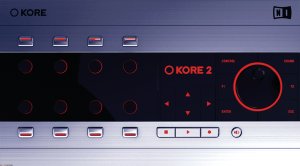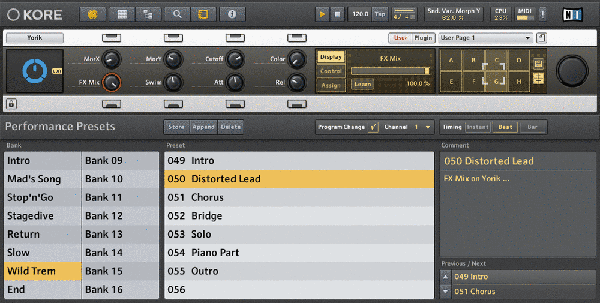Kore 2 Review – Native Instruments
Native Instruments’ Kore 2 is billed as a “super-instrument” – integrating the powerful software engines of their most popular products under a new interface that can be controlled via a dedicated hardware unit. But does it deliver on this lofty moniker?
Kore 2 On The Outside

Although it is possible to buy Kore 2 in a software-only version, the hardware controller really opens up the possibilities for this instrument, particularly in a live environment.
It’s a fairly small and solid unit, with a brushed aluminium chassis giving it a sturdy feel. The illumination on the box is a fairly striking red; the rotary controllers are touch-sensitive and can glow at different levels depending on what settings they are reporting. All in all, it looks quite evil – if Darth Vader was a DJ, he’d probably use one of these.
Kore 2 Under The Hood
Kore 2 can run either as a stand-alone application or as a plugin for your DAW of choice (VST, AU or RTAS). In terms of processing, Kore 2 is powered by the engines of Reaktor, Absynth, Massive, FM8, Kontakt and Guitar Rig – it’s no surprise, therefore, that the quality of sound it produces is second to none.
The other strengths of Kore 2 are usability, tweaking and performance. The browser allows you to quickly scan through all available patches by type and attribute; if you’re looking for a mellow arpeggiated synth sound, you’ll find it in seconds. You can also tag sounds with your own attributes, or remove the default ones if they don’t suit your definitions.
Morphing Sounds In Kore 2
Although patches created in Reaktor may be played in Kore 2, it doesn’t facilitate such grass-roots sound design/synthesis itself. That’s not to say that you can’t create new sounds in Kore – far from it. In fact, new sounds are what really makes Kore 2 shine…
The package comes with 500 patches, but because of Kore’s unique sound morphing feature, the number of sounds directly available out of the box actually numbers in the thousands.
For each patch, eight default parameter settings have been created, and these can be selected directly by pressing the button beside the corresponding knob. The difference in sound between these presets generally ranges from quite subtle to extreme variations. The 8 rotary knobs can be used to smoothly transition between sound settings within patches; this creates a morphing effect that often produces surprising results.
Kore 2 For Performance
You can set up performance patches if you’re planning on using Kore 2 in a live setting, and you can then move through these patches without needing to use a mouse or look at your computer screen.
All the information you need is displayed on the Kore 2 screen, and the various navigation buttons light up to show you what options are available. While I haven’t tried this system at a gig yet, it certainly does seem to tick all the right boxes.

For more details on using Kore 2, the series of videos on the Native Instruments site is a great introduction.
Another essential destination for Kore 2 users is the CDM Kore minisite, which regularly provides updates on Kore-related tips and tricks, as well as a very handy guide to using Kore.
Kore 2 Early Impressions
Personally, I’m just getting to grips with Kore 2, as I’ve only had it for a couple of weeks now, but I must say I really like it. Every time I use it I discover something new, and even without its live potential it would be a worthy investment.
The availability of Kore Sound Packs is another canny move by NI, and provides a wealth of mini-upgrades for those who want to explore new sounds without necessarily investing in a full copy of Reaktor or Massive… and the sonic quality of these smaller products is likely to act as a gateway to the flagships for a large number of users.